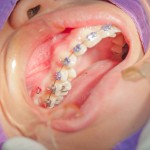
The use of temporary intraoral skeletal anchorage devices (TISADs) to prevent anchorage loss during orthodontic treatment has increased since the development of modified dental implants (mini-screws).
The aim of this review and was to compare the effectiveness of TISADs and conventional anchorage augmentation during space closure by retraction of anterior teeth.
Methods
The PubMed, EMBASE, Cochrane Central Register of Controlled Trials, and Web of Science databases were searched supplemented by hand searches of the European Journal of Orthodontics, Journal of Orthodontics, Journal of Clinical Orthodontics, Seminars in Orthodontics, American Journal of Orthodontics & Dentofacial Orthopaedics, and Angle Orthodontist journals.
Randomised controlled trials (RCTs) and controlled clinical trials (CCTs) of orthodontic patients requiring extraction of the maxillary first premolars and closure of the spaces without anchorage loss were considered. Two reviewers independently selected studies, assessed risk of bias and abstracted data. RCTs were assess using the Cochrane risk of bias tool and the CCTs using a modified Newcastle-Ottawa Scale. Meta-analysis of raw mean differences concerning anchorage loss, tipping of molars, retraction of incisors, tipping of incisors, and treatment duration was conducted.
Results
- 15 studies (7 RCTs, 7 CCTs) involving a total of 616 patients were included.
- 303 patients were treated with TISADs (mini-implants, miniplates, or mini-screws).
- 87.6% of TISADs served successfully throughout the treatment.
- Meta-analysis showed that use of TISADs facilitates better anchorage reinforcement compared with conventional methods.
- On average, TISADs enabled 1.86 mm more anchorage preservation than did conventional methods (P <0.001).
Conclusions
The authors concluded
The results of the meta-analysis showed that TISADs are more effective than conventional methods of anchorage reinforcement. The average difference of 2 mm seems not only statistically but also clinically significant. However, the results should be interpreted with caution because of the moderate quality of the included studies. More high-quality studies on this issue are necessary to enable drawing more reliable conclusions.
Comments
This well conducted review suggests that TISADs may be more effective than traditional methods of providing anchorage support. However, as the authors note some studies may have been excluded because non-English language papers were not included. Owing to the type of intervention blinding of the outcome assessors is challenging so none of the studies scores highly in terms of quality assessment although overall the authors’ considered the evidence to be of moderate quality.
The 2014 Cochrane review of orthodontic anchorage reinforcement by Jambri et al (Dental Elf -21stAug 2014) covers similar but broader ground. They included 15 RCTs concluding:-
There is moderate quality evidence that reinforcement of anchorage is more effective with surgical anchorage than conventional anchorage, and that results from mini-screw implants are particularly promising. While surgical anchorage is not associated with the inherent risks and compliance issues related to extraoral headgear, none of the included studies reported on harms of surgical or conventional anchorage.
Links
Primary paper
Antoszewska-Smith J, Sarul M, Łyczek J, Konopka T, Kawala B. Effectiveness of orthodontic miniscrew implants in anchorage reinforcement during en-masseretraction: A systematic review and meta-analysis. Am J Orthod Dentofacial Orthop. 2017 Mar;151(3):440-455. doi: 10.1016/j.ajodo.2016.08.029. Review. PubMedPMID: 28257728.
Other references
Dental Elf -21stAug 2014 – Review suggests that surgical anchorage is more effective than conventional anchorage for orthodontic treatment

[…] Mini-screw implants for orthodontic anchorage […]